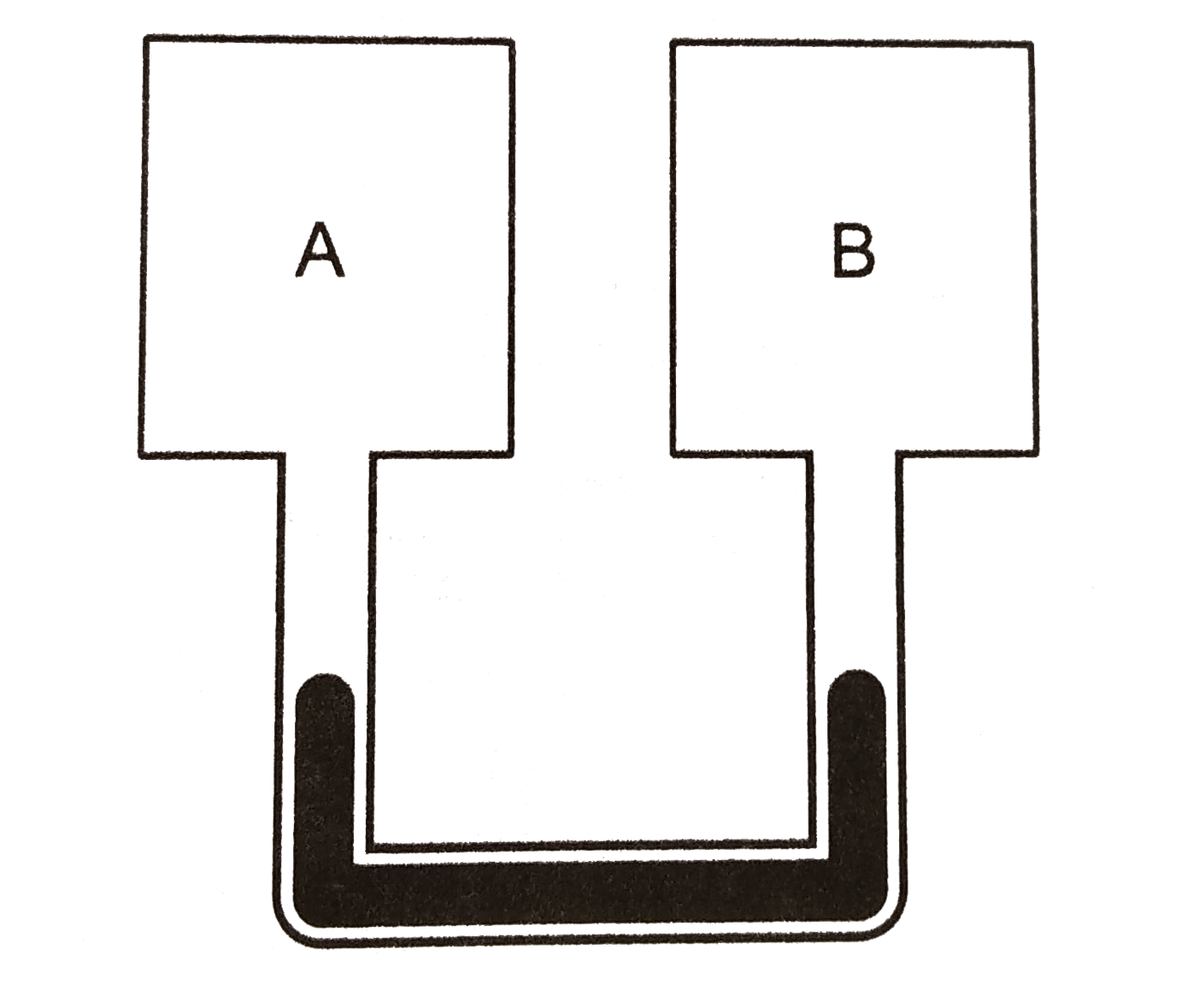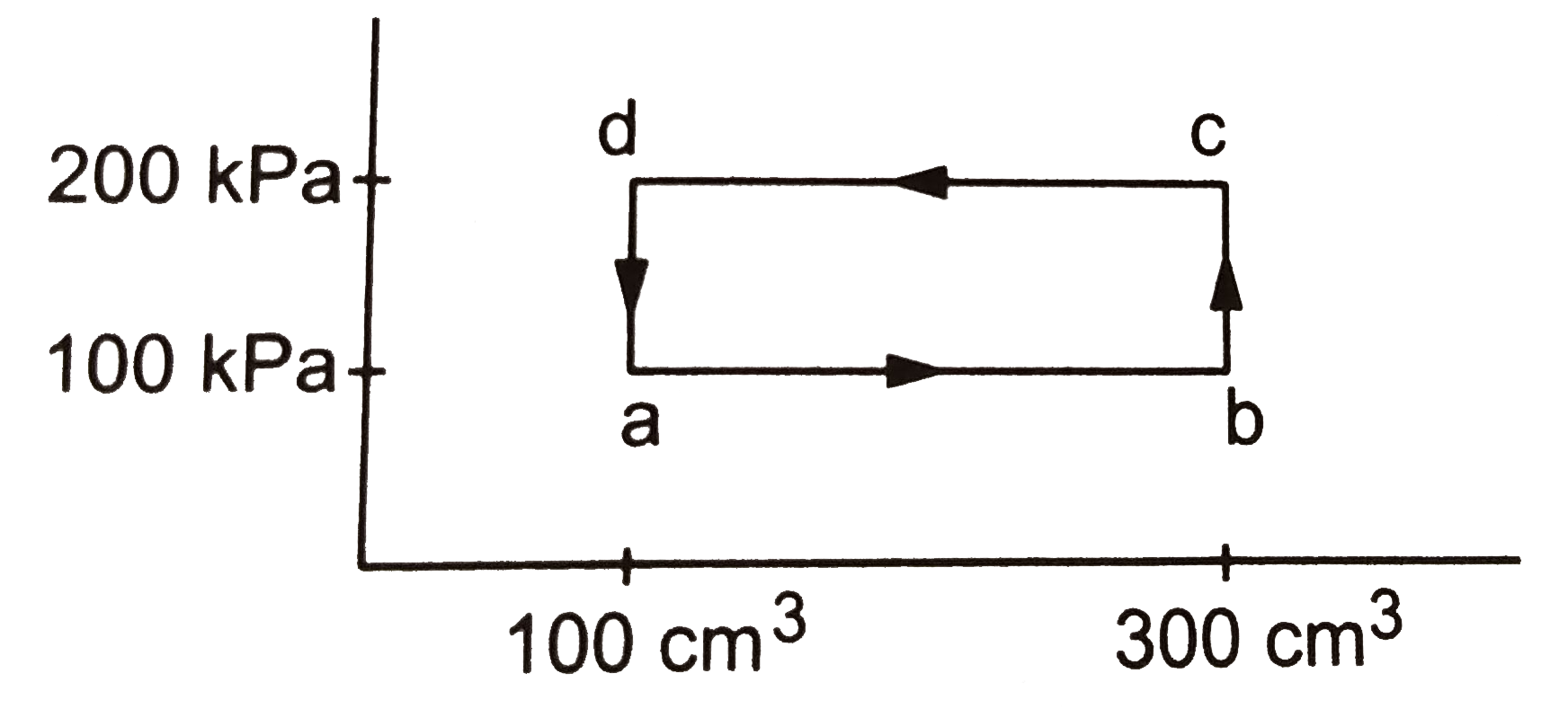Exercises from HC VERMA SPECIFIC HEAT CAPACITIES OF GASES for Class 11
| Class 11 | PHYSICS |
| Chapter | SPECIFIC HEAT CAPACITIES OF GASES |
| HC VERMA | Exercises |
| Medium | English |
| Academic Year | 2023-2024 |
Question 1
A vessel containing one of mole of a monatomic ideal gas (molecular weight = 20gmol) is moving on a floor at a speed of 50ms−1 The vessel is stopped suddenly. Assuming that the mechanical energy lost has gone into the internal energy of the gas , find the rise in its temperature . View SolutionQuestion 3
Figure shows a cylindrical container containing oxyegn (γ=1.4) and closed by a 50 kg frictionless piston. The area of cross section is 100cm(2) , atmospheric pressure is 100kPa+E2 and g is 10 m s^(-2). The cylinder is slowly heated for some time. Find the amount of heat supplied to gas if the piston moves out through a distsnce of 20 cm.
 .View Solution
.View SolutionQuestion 6
A sample of air weighing 1.18g occupies 1.0×103cm3 when kept at 300Kand1.0×105 pa. When 2.0cal of heat is added to it constant volume, its temperature increases by 1∘C. Calculate the amount if heat needed to increases the temperature of air by 1∘C at constant pressure if the mechanical equivalent of heat si 4.2×10−1 . Assume that air behaves as an ideal gas. View SolutionQuestion 7
An ideal gas expands from 100cm3→200cm3 at a constant pressure of 2.0×105 when 50J of heat is supplied to it. Calculate (a) the change in internal energy of the gas , (b) the number of moles in the gas if the initial temperature is 300K , (C ) the molar heat capacity CP at constant pressure and (d) the molar heat capacity Cv at constant volume View SolutionQuestion 15
In Joly's differential steam calorimeter, 3g of an ideal gas is ccontained in a rigid closed sphere at 20∘C. The sphere is heated by steam at 100∘C and it is found that an extra 0.095g of steam has condensed into water as the temperature of the gas becomes constant. Calculate the specific heat capacity of the gas in (Jg−1K−1. The latent heat of vaporization of water=540calg−1. View SolutionQuestion 19
A gas is enclosed in a cylindrical can fitted with a piston. The walls of the can and the piston are adiabatic. The initial pressure , volume and temperature of the gas are 100kPa,400cm3 and 300K respectively. The ratio of the specific heat capacities of the gas is (CpCv=1.5) Find the pressure and the temperature of the gas if it is (a) suddenly compressed (b) slowly compressed to 100cm3. View SolutionQuestion 20
The initial pressure and volume of a given mass of a gas (CpCv=γ) are (p0) and (V0). The gas can exchange heat with surrounding. (a) It is slowly compressed to a volume (V02) and then suddenly compressed to (V04) . Find the final pressure. (b) If the gas is suddenly cpmpressed from the volume (V0→V02) and then slowly compressed to (V04), What will be the final pressure?. View SolutionQuestion 23
Three samples A, B and C of the same gas (γ=1.5) have equal volumes and temperatures. The volume of each sample is doubled, the process being isothermal for A, adiabtic for B and isobaric for C. If the final pressures are equal for the three samples, Find the ratio of the initial pressures. View SolutionQuestion 24
Two samples A and B of the same gas have equal volumes and pressures . The gas is sample A is expanded isothermally to double its volume and the the gas in B is expanded adibatically to double its volume . If the work done by the gas is the same for the two cases, show that gamma satisfies the equation(1−21−γ=(γ−1)1n2. View SolutionQuestion 25
1 liter of an ideal gas (γ=1.5) at 300k is suddenly compressed to half its original volume. (a) Find the ratio of the final pressure to the initial pressure. (b) If the original pressure is 100kpa, find the work done by the gas in the process. (c) What is the change in internal energy? (d) What is the final temperature? (e) the gas is now colled to 300k keeping its pressure constant. Calculate the work done during the process . (f) The gas is now expanded iasothermally to achive its original volume of 1 liters. Calculate the work done by the gas .(g) Calculate the total work done in the cycle. View SolutionQuestion 26
Figure shows a cylindridcal tube with a adibatic walls and fitted with an adiabatic separtor. The separator can be slid into the tube by an external mechanism. An ideal gas(γ=1.5) is injected in the two sides at equal pressures and temperatures . The separator remains in equilibrium at the middel. It is now slid to a position where it divides the tube in the ratio 1:3 Find the ratio of the tempertures in the two parts of the vessel.
 View Solution
View SolutionQuestion 27
Figure shows two rigid vessels A and B, each of volume 200cm3 containg an ideal gas (Cv=12.5JK−1mol−1). The vessels are connected to a manometer tube containing mercury. The pressure in both the vessels is 75 cm mercury and the temperature is 300k. (a) (5−0J) of heat is supplied to the gas in the vessels.(b) (10J) to the gas in the vessels B. Assuming no appreciable transfer of heat from A to B calculate the dufference in the heights of mercury in the two sides of the manometer. Gas constant (R=8.3JK−1mol−1)
 View Solution
View SolutionQuestion 28
Figure shows two vessels with adiabatic walls, one containing 0.1 g of helium (γ=1.67,M=4gmol−1) and the other containing some amount of hydrogen (γ=1.4,M=2gmol−1). Initially , the temperatures of the two gases are equal. The gases electrically heated for some time during which equal amounts of heat are given to the gases. It is found that the temperatures rise through the same amount in the two vessels. Calculate the mass of hydrogen.
 View Solution
View SolutionQuestion 29
Two vessels A and B of equal volume (V0) are connected by a narrow tube which can be closed by a value. The vessels are fitted with piston which can be moved to change the volumes. Initially, the valve is open and the vessels contain an ideal gas (CpCv=γ) at atomspheric pressures(P0) and atmoshpeheric temperature (T0). The walls of the vessels A are diathermic and those of B are adiabatic. The value is now closed and the pistons are slowly pulled out to increase the volumes of the of the vessels to dobuled the original value.(a) Find the temperatures and pressures in the two vessels. (b) The value is now opened for sufficeint time so that the gases acquire a common tempertures and pressures . Find the new values of the temperatuere and the pressures. View SolutionQuestion 30
In given figure, an adiabatic cylindrical tube of volume 2V0 is divided in two equal parts by a frictionless adiabatic separator. An ideal gas in left side of a tube having pressure P1 and temperature T1 where as in the right side having pressure P2 and temperature T2.Cp/Cv=γ is the same for both the gases. The separator is slid slowly and is released at a position where it can stay in equilibrium. Find (a) the final volumes of the two parts (b) the heat given to the gas in the left part and (c) the final common pressure of the gases,
 View Solution
View SolutionQuestion 31
An adiabatic cylindrical tube of cross-sectional area 1cm2 is closed at one end fitted with a piston at the other end. The tube contains 0.03g of an ideal gas . At 1atm pressure and at the temperature of the surrounding, the length of the gas column is 40cm.The piston is suddenly pulled out to double the length of the column. The pressure of the gas falls to 0.355atm. Find the speed of sound in the gas at atmospheric temperature. View Solution
All Exercises from HC VERMA Class 11 PHYSICS SPECIFIC HEAT CAPACITIES OF GASES
- EXERCISES
- EXERCISES
- EXERCISE
- EXERCISES
- EXERCISES
- EXERCISE
- EXERCISES
- EXERCISES
- EXERCISE
- EXAMPLES
- EXAMPLES
- ALL QUESTIONS
- EXAMPLES
- EXAMPLES
- ALL QUESTIONS
- EXAMPLES
- EXAMPLES
- ALL QUESTIONS
- OBJECTIVE 1
- OBJECTIVE 1
- OBJECTIVE 1
- OBJECTIVE 1
- OBJECTIVE 1
- OBJECTIVE 1
- OBJECTIVE 1
- OBJECTIVE 1
- OBJECTIVE 1
- OBJECTIVE 2
- OBJECTIVE 2
- OBJECTIVE 2
- OBJECTIVE 2
- OBJECTIVE 2
- OBJECTIVE 2
- OBJECTIVE 2
- OBJECTIVE 2
- OBJECTIVE 2
- SHORT ANSWER
- SHORT ANSWER
- SHORT ANSWER
- SHORT ANSWER
- SHORT ANSWER
- SHORT ANSWER
- SHORT ANSWER
- SHORT ANSWER
- SHORT ANSWER
- WORKED OUT EXAMPLES
- WORKED OUT EXAMPLES
- WORK OUT
- WORKED OUT EXAMPLES
- WORKED OUT EXAMPLES
- WORK OUT
- WORKED OUT EXAMPLES
- WORKED OUT EXAMPLES
- WORK OUT


